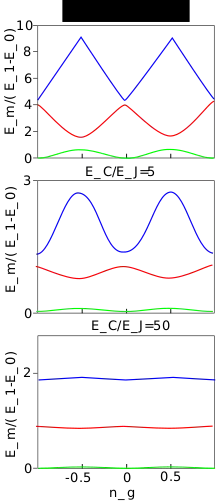Transmon
In quantum computing, and more specifically in superconducting quantum computing, a transmon is a type of superconducting charge qubit that was designed to have reduced sensitivity to charge noise. The transmon was developed by Robert J. Schoelkopf, Michel Devoret, Steven M. Girvin and their colleagues at Yale University in 2007.[1][2] Its name is an abbreviation of the term transmission line shunted plasma oscillation qubit; one which consists of a Cooper-pair box "where the two superconductors are also capacitatively shunted in order to decrease the sensitivity to charge noise, while maintaining a sufficient anharmonicity for selective qubit control".[3]
.png.webp)
| Part of a series on |
| Quantum mechanics |
|---|
The transmon achieves its reduced sensitivity to charge noise by significantly increasing the ratio of the Josephson energy to the charging energy. This is accomplished through the use of a large shunting capacitor. The result is energy level spacings that are approximately independent of offset charge. Planar on-chip transmon qubits have T1 coherence times ~ 30 μs to 40 μs.[5] By replacing the superconducting transmission line cavity with a three-dimensional superconducting cavity, recent work on transmon qubits has shown significantly improved T1 times, as long as 95 μs.[6][7] These results demonstrate that previous T1 times were not limited by Josephson junction losses. Understanding the fundamental limits on the coherence time in superconducting qubits such as the transmon is an active area of research.
Comparison to Cooper-Pair Box

The transmon design is similar to the first design[8] of Cooper pair box, both are described by the same Hamiltonian, with the only difference being the increase in the ratio, achieved by shunting the Josephson junction with an additional large capacitor. Here is the Josephson energy of the junction, and is the charging energy inversely proportional to the total capacitance of the qubit circuit. The benefit of increasing the ratio is insensitivity to charge noise - the energy levels become independent of electrical charge across the junction, thus the coherence times of the qubit are prolonged. The disadvantage is decrease in the anharmonicity , where is the energy of the state . Reduced anharmonicity complicates the device operation as a two level system, e.g. exciting the device from the ground state to the first excited state by a resonant pulse also populates the second excited state. This complication is overcome by complex microwave pulse design, that takes into account the higher energy levels, and prohibits their excitation by destructive interference.
Measurement, control and coupling of the transmons is performed by means of microwave resonators with techniques of circuit quantum electrodynamics, also applicable to other superconducting qubits. The coupling to the resonators is done by putting a capacitor between the qubit and the resonator, at a point where the resonator electromagnetic field is biggest. For example, in IBM Quantum Experience devices, the resonators are implemented with "quarter wave" coplanar waveguide with maximal field at the signal-ground short at the waveguide end, thus every IBM transmon qubit has a long resonator "tail". The initial proposal included similar transmission line resonators coupled to every transmon, becoming a part of the name. However, charge qubits operated at a similar regime, coupled to different kinds of microwave cavities are referred to as transmons as well.
See also
References
- J. Koch et al., "Charge-insensitive qubit design derived from the Cooper pair box," Phys. Rev. A 76, 042319 (2007), doi:10.1103/PhysRevA.76.042319, arXiv:cond-mat/0703002
- J.A. Schreier et al., "Suppressing charge noise decoherence in superconducting charge qubits," Phys. Rev. B 77, 180502 (2008), doi:10.1103/PhysRevB.77.180502, arXiv:0712.3581
- Fink, Johannes M. (2010). Quantum Nonlinearities in Strong Coupling Circuit QED (Ph.D.). ETH Zurich.
- J. M. Gambetta, J. M. Chow and M. Steffen, "Building logical qubits in a superconducting quantum computing system", npj Quantum Information 3, 2 (2017), doi:10.1038/s41534-016-0004-0
- R. Barends et al., "Coherent Josephson Qubit Suitable for Scalable Quantum Integrated Circuits," Phys. Rev. Lett., 111, (2013), doi:10.1103/PhysRevLett.111.080502, arXiv:1304:2322
- H. Paik et al., "Observation of high coherence in Josephson junction qubits measured in a three-dimensional circuit QED architecture," Phys. Rev. Lett. 107, 240501 (2011), doi:10.1103/PhysRevLett.107.240501, arXiv:1105.4652
- C. Rigetti et al., "Superconducting qubit in waveguide cavity with coherence time approaching 0.1 ms," Phys. Rev. B 86, 100506(R) (2012), doi:10.1103/PhysRevB.86.100506, arXiv:1202.5533
- Bouchiat, V.; Vion, D.; Joyez, P.; Esteve, D.; Devoret, M. H. (1998). "Quantum coherence with a single Cooper pair". Physica Scripta. 1998 (T76): 165. doi:10.1238/Physica.Topical.076a00165. ISSN 1402-4896.
